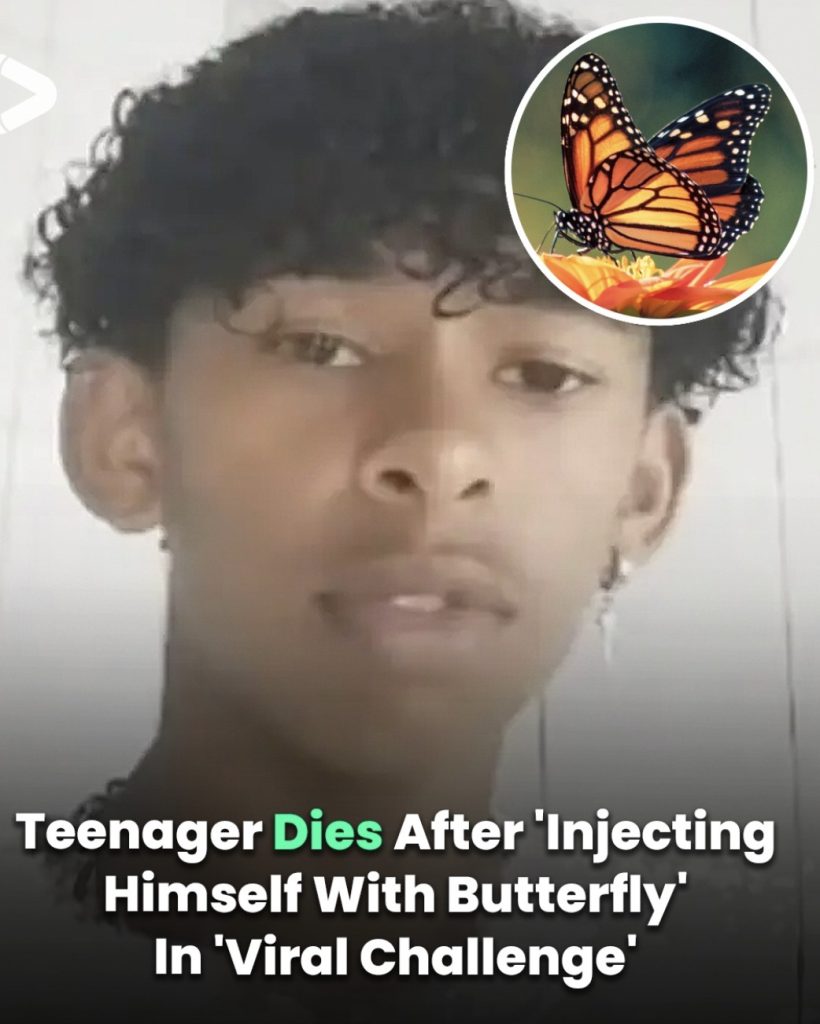In a deeply heartbreaking and alarming incident, a 14-year-old Brazilian boy named Davi Nunes Moreira tragically lost his life after taking part in a dangerous internet challenge that went horribly wrong. Driven by a desire for attention on social media, Davi made the fatal decision to inject a mixture of crushed butterfly wings and water into his leg—an act that would ultimately lead to his untimely and excruciating death.

What began as a misguided attempt to follow a viral trend quickly spiraled into a devastating medical emergency. Within hours of the injection, Davi began showing serious symptoms. He limped, vomited, and appeared to be in distress. At first, when questioned by his concerned father, he claimed he had merely hurt himself while playing. However, as his condition worsened, his father made a disturbing discovery: a used syringe hidden under the boy’s pillow. It was at that moment that Davi was rushed to the hospital and eventually admitted to medical staff what he had done.
The teenager had taken a dead butterfly, crushed it into powder, mixed it with water, and injected the resulting fluid into his right leg. Though the full details of the origin of this challenge remain unclear, it is widely believed that the act was inspired by a viral trend circulating on social media platforms. According to reporting from the Daily Mail, some Brazilian outlets speculated that Davi might have been mimicking an online experiment rather than participating in a formal challenge. However, just before his death, Davi reportedly denied those claims.
Despite the efforts of medical professionals at a hospital in Planalto, Brazil, Davi’s condition continued to decline. For seven agonizing days, he battled pain, infection, and growing complications. Doctors tried desperately to reverse the damage caused by the injection, but their efforts were ultimately unsuccessful. He passed away in February, leaving behind a devastated family and a community grappling with grief.
Luiz Fernando D. Relvas, a specialist at the hospital, commented on the mysterious and complex nature of the incident. Speaking to VivaBem, Relvas said, “It could have been an embolism, an infection, or an allergic reaction.” He went on to explain the uncertainty surrounding the injection, noting that doctors did not know how the mixture was prepared or the exact size of the butterfly fragments introduced into the body. Even a tiny air bubble left in the syringe could have led to a fatal embolism—an event that can cause rapid and deadly deterioration.
In addition to those possibilities, there is now an ongoing investigation into whether the butterfly itself may have contributed toxins to the mixture that triggered systemic organ failure and septic shock, which could have been the true cause of Davi’s death. Professor Marcelo Duarte, a leading entomologist and the director of the Zoology Museum at São Paulo University, weighed in on this theory. According to him, while butterflies are not commonly considered dangerous to humans, their biology is far more complex than most people realize. “The fluids present in butterflies have not been thoroughly studied in terms of toxicity to humans,” he said. This lack of scientific understanding means that Davi’s tragic experiment may have exposed him to unknown biological dangers.
Meanwhile, authorities in Vitoria da Conquista are actively conducting a thorough investigation. The Civil Police have stated that a full autopsy will be carried out to determine the precise cause of death. The results of this examination are expected to shed light on whether Davi’s death was primarily due to physical trauma, an allergic reaction, toxic substances, or a combination of factors.
Sadly, this isn’t an isolated case. The rise of viral challenges online—often presented as dares or social experiments—has led to a wave of dangerous behavior among teens and young adults worldwide. These challenges, while sometimes seeming harmless or humorous on the surface, can have catastrophic results when they involve physical risks, untested substances, or extreme environments.
Just a few months before Davi’s death, another Brazilian fell victim to the allure of online fame through a similar stunt. An influencer known as “Thammy MC” nearly lost her toes after attempting a challenge involving submerging her feet in a mixture of ice and salt. With over two million followers, she likely felt pressured to perform the risky act to entertain her audience. The challenge caused severe frostbite, turning her feet black and landing her in the hospital. Doctors were on the verge of amputating her toes before she began to recover—just barely avoiding a lifelong disability.
These cases serve as sobering reminders of the real-life consequences of reckless online behavior. While social media can be a powerful platform for connection, creativity, and self-expression, it also carries the risk of fostering dangerous trends that prey on the insecurities and impressionability of young users. The desire to go viral, gain followers, or simply be seen can sometimes override a person’s better judgment—especially in adolescents whose brains are still developing and who may not fully grasp the risks involved.
Parents, educators, and digital platforms alike have a role to play in curbing the spread of such harmful content. Open communication with teens about the potential dangers of these trends is essential. Social media companies must also step up by monitoring and removing content that promotes unsafe behavior or misinformation. Furthermore, public awareness campaigns can help educate users about the consequences of imitating unverified internet stunts.
Davi Nunes Moreira’s story is a tragic example of how a single poor decision, made in the pursuit of online recognition, can have irreversible consequences. As his family mourns an unimaginable loss, his death stands as a grim warning to others. No moment of internet fame is worth the price of a life. Let this be a wake-up call—not only to teens but to everyone navigating the digital world—to think twice, act responsibly, and value life over likes.





